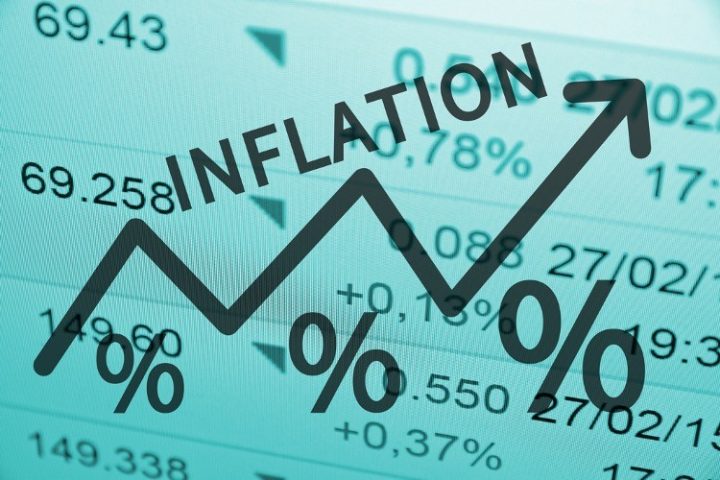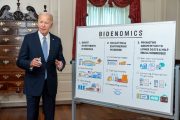
Are Americans better or worse off under a Joe Biden presidency? For many, the determining factor is the state of their pocketbooks.
According to a survey of consumer sentiment published Friday by the University of Michigan, inflation expectations are markedly up, with consumers expecting inflation to run at 4.2 percent 12 months from now, in contrast to the expectation of 3.2 percent last month, per Breitbart News. Meanwhile, the long-run inflation expectation went up from 2.8 percent last month to 3.0 percent this month.
What this suggests is that the public has less confidence now in the Federal Reserve’s policies for bringing down inflation. Seemingly in confirmation of this belief, the Commerce Department announced on Friday that prices in September went up 0.4 percent for the second month in a row — a leap from the 0.2 percent increases that had taken place over the summer.
A similar poll conducted for The Economist this month found that 50 percent of adults in the United States believe inflation will be higher in six months than it is right now — a surge from polling in September, which showed 47 percent expecting inflation to go up.
Furthermore, Americans have a low opinion of Biden’s efforts to counteract inflation — an issue of significance to a large swath of the public. As Breitbart notes:
Americans consistently give President Joe Biden a low rating on his administration’s efforts to combat inflation. Just 32 percent of Americans say they approve of the administration’s inflation policies and 61 percent disapprove, including 45 percent who strongly disapprove. Among independents, a key swing vote in presidential elections, just 23 percent approve and 65 percent disapprove.
Seventy-four percent of Americans say inflation is a “very important” issue, with another 20 percent rating it as somewhat important. Twenty-four percent say inflation is the most important issue facing the country, higher than the second- and third-ranking issues — health care and climate change — combined.
At the same time, the University of Michigan’s consumer sentiment index dropped six percent in October after keeping stable for two months.
The director of the survey, Joanne Hsu, said of this development, “This decline was driven in large part by higher-income consumers and those with sizable stock holdings, consistent with recent weakness in equity markets. Across all consumers, one-year expected business conditions plunged 16% and expectations over consumers’ own personal finances in the year ahead fell 8%, reflecting ongoing concerns about inflation and, to a lesser degree, uncertainty over the implications of negative news both domestically and abroad.”
Inflation is having a devastating effect on households across Middle America as the prices of food and other essentials continue to rise. Grocery prices have gone up nearly 17 percent over the past two years, according to the Bureau of Labor Statistics — a spike that is outpacing overall annual inflation.
Even as inflation escalates, the Federal Reserve and the federal government are doing little to restore any semblance of fiscal responsibility.
On the 20th of this month, the U.S. Treasury Department released a statement for Fiscal Year 2023, claiming a “strong economic recovery” helped to keep the deficit more than $1 trillion lower than when President Biden took office.
However, the year-end data from the September 2023 Monthly Treasury Statement of Receipts and Outlays showed little cause to celebrate, as the nation is still buried in growing debt, with a FY deficit at “$1.7 trillion; $320 billion higher than the prior year’s deficit.”
The statement also revealed that as a percentage of GDP, the deficit went from 5.4 percent in fiscal year 2022 to 6.3 percent in this year. The statement went on to acknowledge that “total Federal borrowing from the public increased by $2.0 trillion during FY 2023 to $26.2 trillion. The increase in borrowing included $1.7 trillion to finance the deficit as well as $0.3 trillion in net borrowing related to other transactions such as changes in cash balances and net disbursements for Federal credit programs.”
America’s trade deficits and the gutting of the nation’s productive base are also important factors contributing to inflation that often go undiscussed. As The New American explained in an in-depth piece about the consequences of trade deficits:
Of the 21 countries that caused hyperinflation of their currencies, 17 were running trade deficits at the time their currencies imploded.
… A currency hyperinflates when producers in a country can’t produce enough goods — create enough wealth — to pay for government services, and the government decides to print money to pay for its employees and services. When people both at home and abroad realize that the currency produced by a country far outstrips the value of the saleable goods available in that country, price inflation runs rampant, and if enough money is printed, the currency can lose value rapidly, becoming virtually worthless. It is a truism that if a country purchased all goods from abroad, a country’s currency would quickly devalue, providing a tie between trade deficits and currency crashes.
Unfortunately, America’s political class has seen these problems coming for decades but done nothing to prevent or fix them, preferring instead to fiddle while the nation burns.




